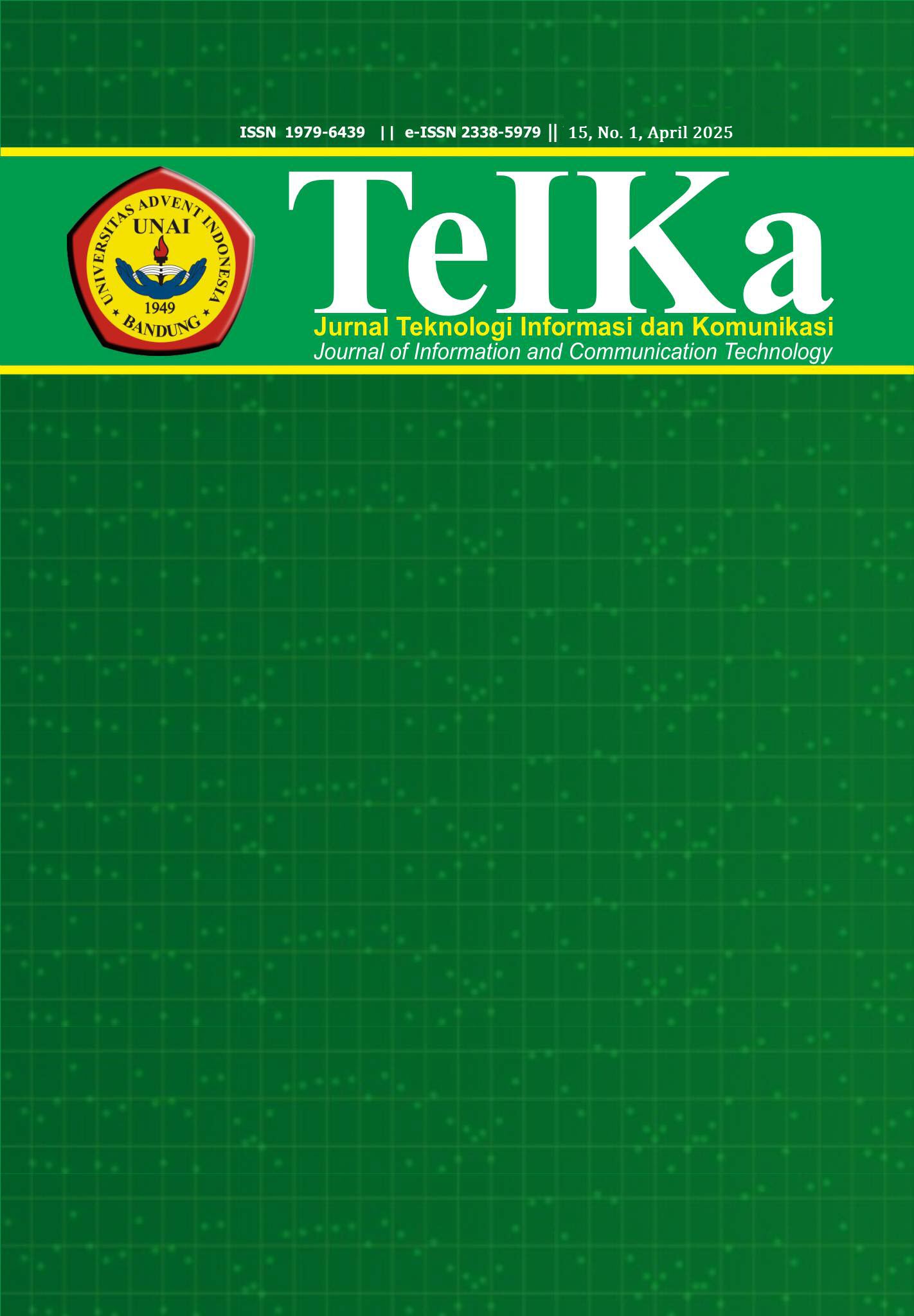Prototype Alat Pendeteksi & Pengukur Kebocoran Gas Berbasis IoT
Kata Kunci:
IoT, MQ2 Sensor, NodeMCU, TelegramAbstrak
Penggunaan gas LPG yang luas di rumah tangga dan industri membawa risiko kebocoran yang berpotensi menyebabkan kebakaran. Penelitian ini bertujuan untuk mengembangkan prototipe alat pendeteksi dan pengukur kebocoran gas LPG berbasis IoT, yang memungkinkan pemantauan jarak jauh melalui aplikasi Telegram. Metode penelitian mencakup analisis kebutuhan, perancangan perangkat keras dan lunak, implementasi sistem, serta pengujian dan evaluasi. Hasil penelitian menunjukkan bahwa sistem yang dikembangkan menggunakan sensor MQ2 dan NodeMCU mampu mendeteksi kebocoran gas secara akurat dan mengirimkan notifikasi real-time kepada pengguna. Sistem ini memberikan peringatan dini yang efektif, meningkatkan keselamatan pengguna, serta mengatasi keterbatasan indera penciuman manusia dalam mendeteksi kebocoran gas.
Unduhan
Referensi
M. Alparisi, “PERANCANGAN SISTEM KEAMANAN BERKAS BERBASIS IoT MENGGUNAKAN FINGERPRINT DENGAN NOTIFIKASI VIA TELEGRAM,” INFOKOM (Informatika & Komputer), vol. 9, no. 1, pp. 46–56, 2021, doi: 10.56689/infokom.v9i1.480.
R. Andriawan, D. Berliani, Y. Sarigih, and U. Latifa, “Rancangan Bangun Sistem Pendeteksi Kebocoran Gas LPG Menggunakan Nodemcu ESP866 Berbasis Internet,” Sci. Phys. Educ. J., vol. 6, no. 1, pp. 33–41, 2022, doi: 10.31539/spej.v6i1.4394.
G. Sanhaji, I. Pratama Putra, and I. Abdul Rojak, “Rancang Bangun Sistem Monitoring Kebocoran Gas, Suhu, dan Kelembapan pada Dapur Berbasis Internet of Things Menggunakan Mikrokontroler Wemos D1 Mini,” Ranah Res. J. Multidiscip. Res. Dev., vol. 5, no. 4, pp. 335–343, 2023, doi: 10.38035/rrj.v5i4.785.
F. Benfano Soewito, “Deteksi kebocoran gas LPG dengan sensor MQ (based IOT),” 2020. https://mti.binus.ac.id/2020/09/03/deteksi-kebocoran-gas-lpg-dengan-sensor-mq-based-iot/ (accessed Jun. 28, 2024).
K. E. S. D. M. Dan, “Konversi Minyak Tanah ke LPG : Menggerakkan Perekonomian, Menghemat Energi,” 2010. https://esdm.go.id/id/media-center/arsip-berita/konversi-minyak-tanah-ke-lpg-menggerakkan-perekonomian-menghemat-energi (accessed Jun. 27, 2024).
M. A. Prasetyo and N. Paramytha, “Pengembangan Sistem Pendeteksi Kebocoran Gas LPG dengan Teknologi IoT dan Sensor MQ5,” J. Ampere, vol. 8, no. 2, pp. 103–115, 2023, doi: 10.31851/ampere.v8i2.9240.
Indobot, “Datasheet NodeMCU ESP8266 Lengkap,” 2022. https://blog.indobot.co.id/datasheet-nodemcu-esp8266-lengkap-dengan-pin-dan-cara-akses/ (accessed Jun. 28, 2024).
A. D. Kurniawan, “Design and Implementation of Home Security Using Telegram Botfather,” Fidel. J. Tek. Elektro, vol. 2, no. No. 1, pp. 11–15, 2020, doi: 10.52005/fidelity.v2i1.105.
I. Panji Aryan and C. Bella, “Rancangan Alat Deteksi Kebocoran Gas Berbasis Android Menggunakan Sensor Mq-2,” Portaldata.org, vol. 1, no. 3, pp. 2021–2022, 2021.
E. Soesilo and I. Fayuza, “Prototype Alat Pendeteksi Kebocoran Gas LPG Berbasis IOT,” J. Tek. Ind. Terintegrasi, vol. 6, no. 3, pp. 862–879, 2023, doi: 10.31004/jutin.v6i3.17664.
E. A. Prastyo, “Review Sensor Gas MQ-2: Deteksi Gas dengan Arduino,” 2024. https://www.arduinoindonesia.id/2024/06/review-sensor-gas-mq-2-deteksi-gas-dengan-arduino.html (accessed Mar. 25, 2025).
R. Harahap, “10 Resiko Usaha Gas Elpiji yang Harus Diketahui,” 2021. https://www.kosngosan.com/2021/12/resiko-usaha-gas-elpiji.html (accessed Jun. 28, 2024).
Indobot, “Apa itu LCD dalam Elektronika?,” 2023. https://blog.indobot.co.id/apa-itu-lcd-dalam-elektronika/ (accessed Jun. 18, 2024).
E. A. Prastyo, “Pengertian dan Penjelasan tentang Piezoelectric Buzzer,” 2023. https://www.edukasielektronika.com/2022/10/pengertian-dan-penjelasan-tentang.html (accessed Mar. 25, 2025).
##submission.downloads##
Diterbitkan
Cara Mengutip
Terbitan
Bagian
Lisensi
Hak Cipta (c) 2025 TeIKa

Artikel ini berlisensiCreative Commons Attribution-ShareAlike 4.0 International License.
The submitting author warrants that the submission is original and that she/he is the author of the submission together with the named co-authors; to the extend the submission incorporates text passages, figures, data or other material from the work of others, the submitting author has obtained any necessary permission.
Articles in this journal are published under the Creative Commons Share Alike Attribution Licence (CC-BY-SA What does this mean?). This is to get more legal certainty about what readers can do with published articles, and thus a wider dissemination and archiving, which in turn makes publishing with this journal more valuable for you, the authors.
By submitting an article the author grants to this journal the non-exclusive right to publish it. The author retains the copyright and the publishing rights for his article without any restrictions.









